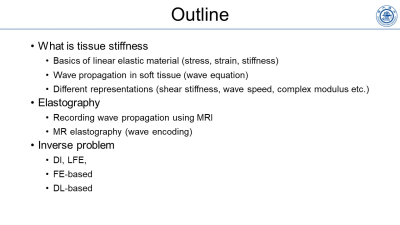Sunrise Course
Non-Standard MR Contrast Mechanisms: From Properties to Function I: Tissue Stiffness: MR Elastography
ISMRM & ISMRT Annual Meeting & Exhibition • 03-08 June 2023 • Toronto, ON, Canada

| 07:00 |
 |
Tissue Stiffness: MR Elastography: Theory
Yuan Feng
Keywords: Contrast mechanisms: Elastography This lecture will introduce the fundamentals of tissue stiffness and its measurement using Magnetic Resonance Elastography (MRE). The basics of linear elasticity, such as stress, strain, and shear modulus, will be covered. Wave propagation in materials will be discussed along with the wave equation. Representations of tissue stiffness, i.e., shear stiffness, wave speed, complex modulus, etc., and their physical meanings will also be discussed. Theory and implementations of MRE will be presented. Finally, the inversion algorithms (e.g., direct inversion, local field estimation, finite element method, and machine learning) to estimate tissue stiffness will be discussed. |
| 07:30 |
Tissue Stiffness: MR Elastography: Case Study/Application
Lauriane Jugé
Keywords: Contrast mechanisms: Elastography This talk will present key clinical applications of MR elastography. MR elastography is a useful imaging technique for mapping the mechanical properties of soft tissues in vivo, such as the brain, liver, muscles, or tumours. It is an established diagnostic technique for staging liver fibrosis and has increasing relevance in investigating complex physiological and pathological processes, including neurodegenerative diseases and cancers. Recent advancements in MR elastography, allowing mapping of anisotropic tissue properties and characterisation of nonlinear viscoelastic behaviour under static loading, will also be covered to discuss future applications of MR elastography. |
The International Society for Magnetic Resonance in Medicine is accredited by the Accreditation Council for Continuing Medical Education to provide continuing medical education for physicians.